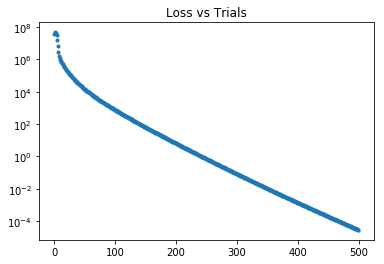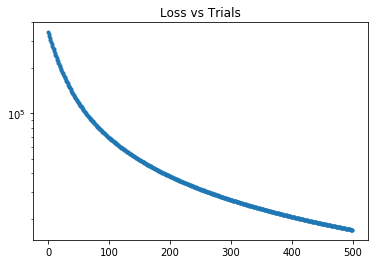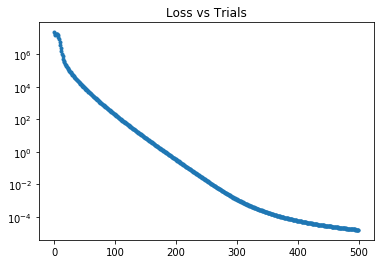Neural Networks
Contents
64. Neural Networks#
import torch
from torch.autograd import Variable
import torch.nn as nn
import torch.nn.functional as F
import numpy as np
import matplotlib.pyplot as plt
import time
# import plotly.plotly as py
# from plotly.graph_objs import *
From http://pytorch.org/tutorials/beginner/pytorch_with_examples.html#nn-module
65. Basic Manipulations#
Matrix/Tensor multiplication
mat.dot(mat2)
temp1 = np.linspace(0,1,10*5).reshape(5,10)
temp2 = ( (np.linspace(0,1,10*3) )**2 ).reshape(10,3)
temp1.dot(temp2).shape
(5, 3)
Network using numpy, \(Y_p\) is the predicted output, \(R()\) is the activation function, \(W_1\) is the first weight matrix, \(W_2\) is the second weight matrix
In the spirit of auto-grad, we need to use the chain rule.
The next step is to calculate the grad and propagate back. Autograd is basically the chain rule. We are insterested in updating the two weight matrices, thus we need \(dL/dW_1\) and \(dL/dW_2\) element-wise.
As \(dL/dW_2\) is much easier to calculate.
# -*- coding: utf-8 -*-
# import numpy as np
# N is batch size; D_in is input dimension;
# H is hidden dimension; D_out is output dimension.
N, D_in, H, D_out = 64, 1000, 100, 10
# Create random input and output data
x = np.random.randn(N, D_in)
y = np.random.randn(N, D_out)
# x = np.linspace(0,1,N*D_in).reshape( N, D_in )
# y = x**2
# Randomly initialize weights
w1 = np.random.randn(D_in, H)
w2 = np.random.randn(H, D_out)
trial_data = []
learning_rate = 1e-6
for t in range(500):
# Forward pass: compute predicted y
h = x.dot(w1)
h_relu = np.maximum(h, 0) # linear activation
y_pred = h_relu.dot(w2)
# Compute and print loss
loss = np.square(y_pred - y).sum()
# print(t, loss)
# Backprop to compute gradients of w1 and w2 with respect to loss
grad_y_pred = 2.0 * (y_pred - y)
grad_w2 = h_relu.T.dot(grad_y_pred)
grad_h_relu = grad_y_pred.dot(w2.T)
grad_h = grad_h_relu.copy()
grad_h[h < 0] = 0
grad_w1 = x.T.dot(grad_h)
# Update weights
w1 -= learning_rate * grad_w1
w2 -= learning_rate * grad_w2
trial_data.append( [t, loss] )
trial_data_plt = np.transpose(trial_data)
plt.semilogy( trial_data_plt[0], trial_data_plt[1], '.' )
plt.title('Loss vs Trials')
plt.show()

The same program would be translated into PyTorch version directedly.
PyTorch comes with
clampfunction that calcualtes RELU.PyTorch comes with tensor operators that are of high performance.
dtype=torch.FloatTensor
torch_x = torch.randn(N, D_in).type(dtype)
torch_y = torch.randn(N,D_out).type(dtype)
torch_w1 = torch.randn(D_in, H).type(dtype)
torch_w2 = torch.randn(H, D_out).type(dtype)
torch_trial_data = []
for t in range(500):
torch_h = torch_x.mm(torch_w1) #matrix multiply
torch_h_relu = torch_h.clamp(min=0) # this is basically RELU
torch_y_pred = torch_h_relu.mm(torch_w2)
torch_loss = (torch_y_pred - torch_y).pow(2).sum()
# print(t, torch_loss)
torch_grad_y_pred = 2.0*(torch_y_pred - torch_y)
torch_grad_w2 = torch_h_relu.t().mm(torch_grad_y_pred)
torch_grad_h_relu = torch_grad_y_pred.mm(torch_w2.t())
torch_grad_h = torch_grad_h_relu.clone()
torch_grad_h[torch_h < 0] = 0
torch_grad_w1 = torch_x.t().mm(torch_grad_h)
torch_w1 -= learning_rate * torch_grad_w1
torch_w2 -= learning_rate * torch_grad_w2
torch_trial_data.append( [t, torch_loss] )
# print(t, torch_loss)
torch_trial_data_plt = np.transpose(torch_trial_data)
plt.semilogy( torch_trial_data_plt[0], torch_trial_data_plt[1], '.' )
plt.title('Loss vs Trials')
plt.show()

On the other hand, PyTorch also provides autograd which works out the chain rule by itself if data is defined through variables.
ta_x = Variable( torch.randn(N, D_in).type(dtype), requires_grad=False )
ta_y = Variable( torch.randn(N, D_out).type(dtype), requires_grad=False )
ta_w1 = Variable(torch.randn(D_in, H).type(dtype), requires_grad = True)
ta_w2 = Variable(torch.randn(H, D_out).type(dtype), requires_grad = True)
ta_trial_data = []
learning_rate = 1e-6
for t in range(500):
ta_y_pred = ta_x.mm( ta_w1 ).clamp( min=0 ).mm(ta_w2)
ta_loss = (ta_y_pred - ta_y).pow(2).sum()
# print(t, ta_loss.data[0])
ta_loss.backward()
ta_w1.data -= learning_rate* ta_w1.grad.data
ta_w2.data -= learning_rate* ta_w2.grad.data
ta_w1.grad.data.zero_()
ta_w2.grad.data.zero_()
ta_trial_data.append( [t, ta_loss.data[0]] )
# print(t, ta_loss.data[0])
ta_trial_data_plt = np.transpose(ta_trial_data)
plt.semilogy( ta_trial_data_plt[0], ta_trial_data_plt[1], '.' )
plt.title('Loss vs Trials')
plt.show()

print(ta_trial_data[-1])
[499, 1.5851306670811027e-05]
This is a test of the framework. RELU is not the best practice for this task.

